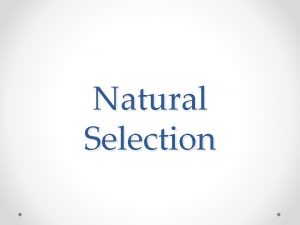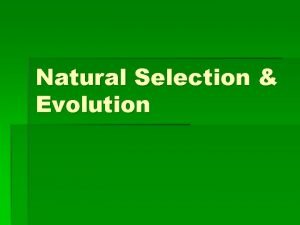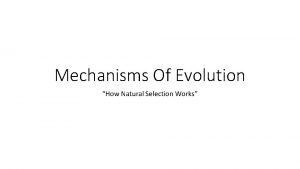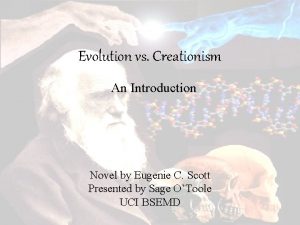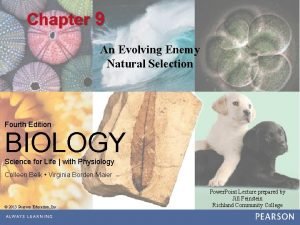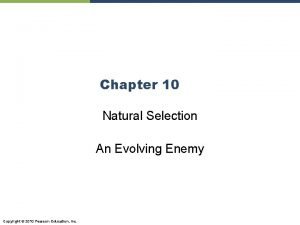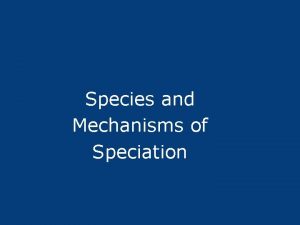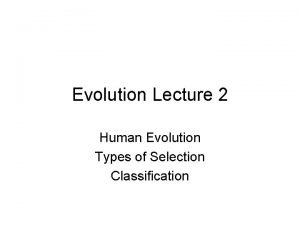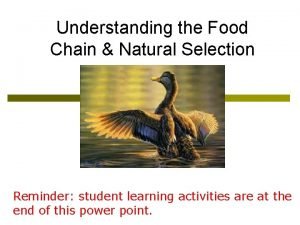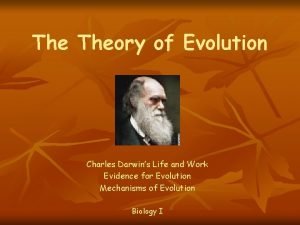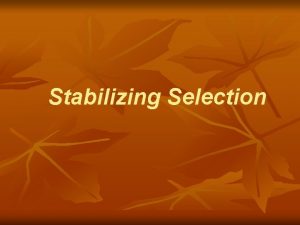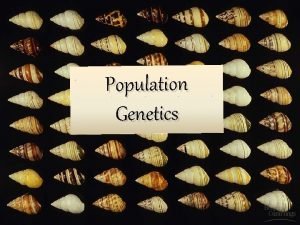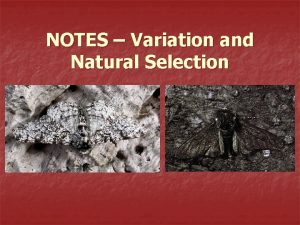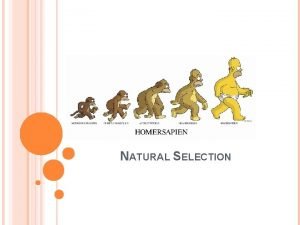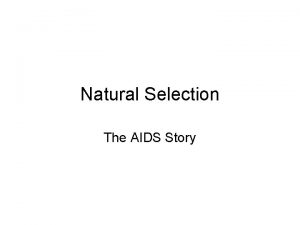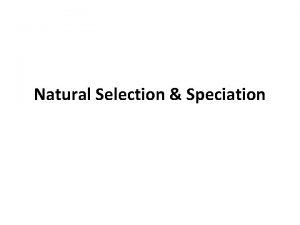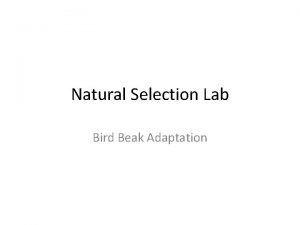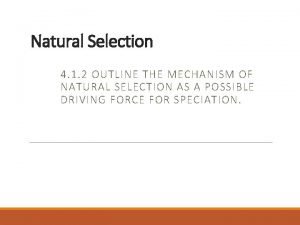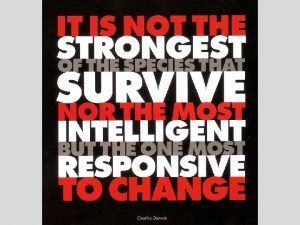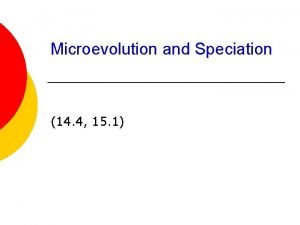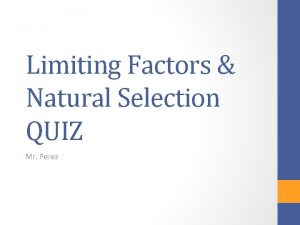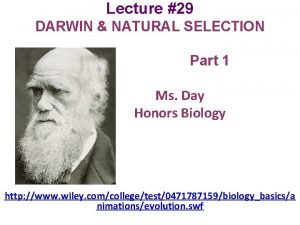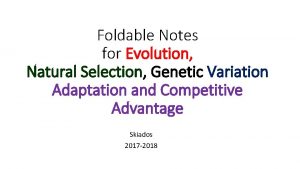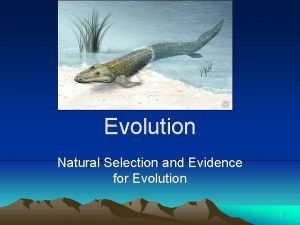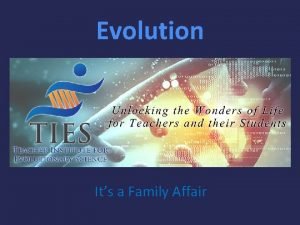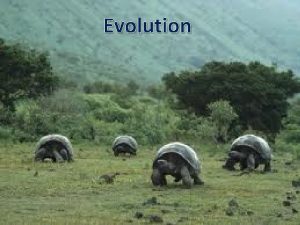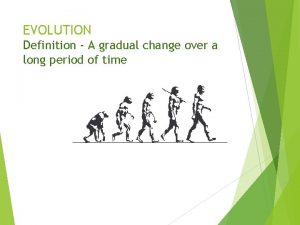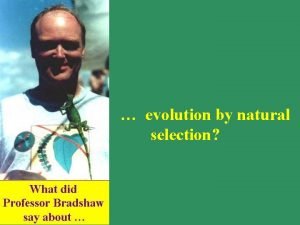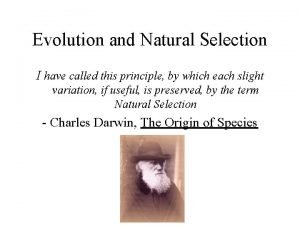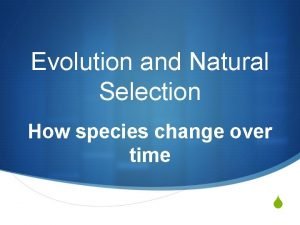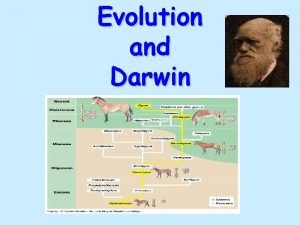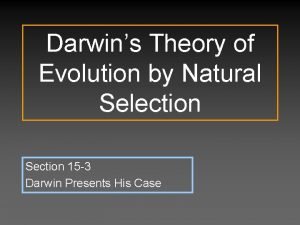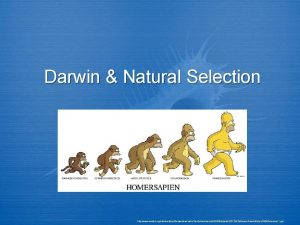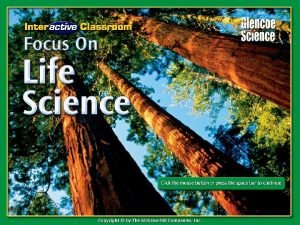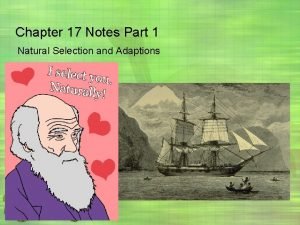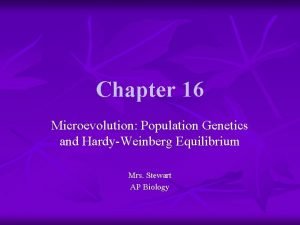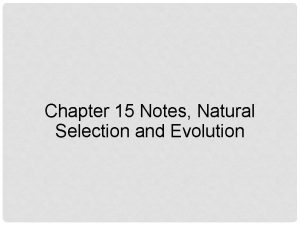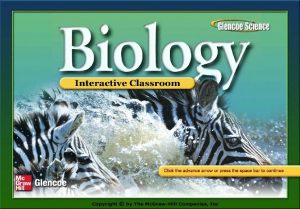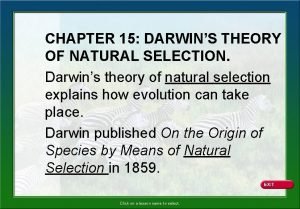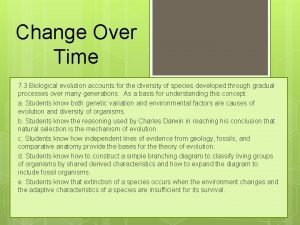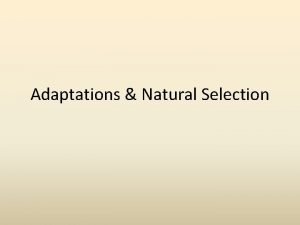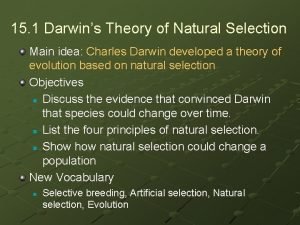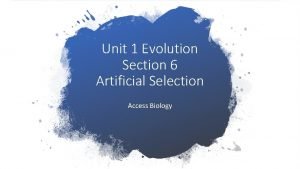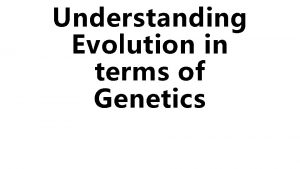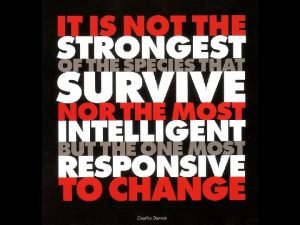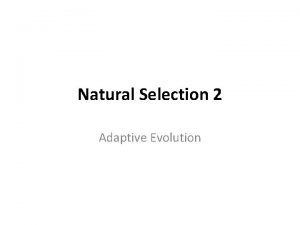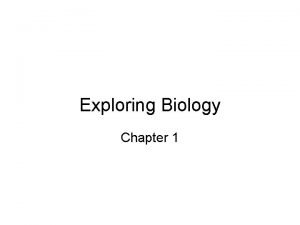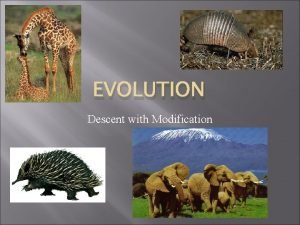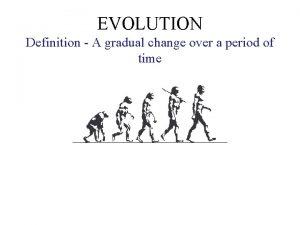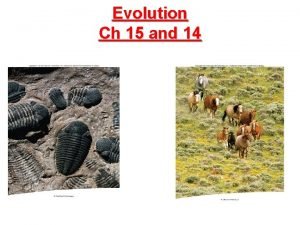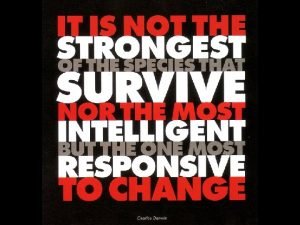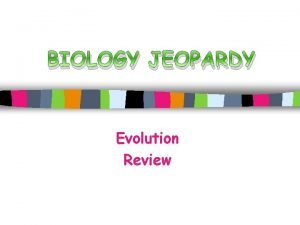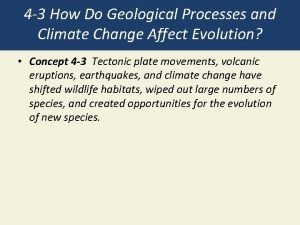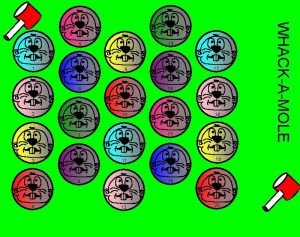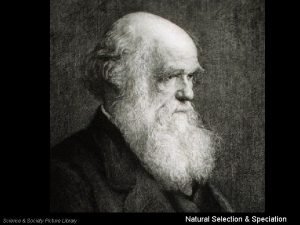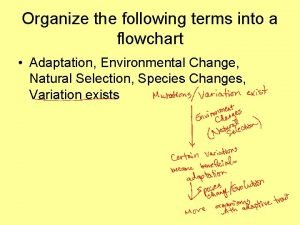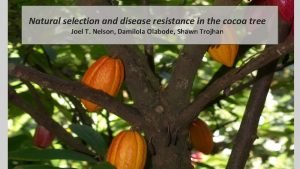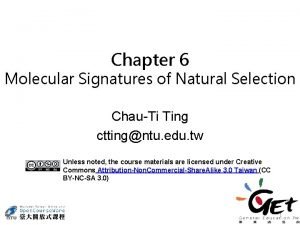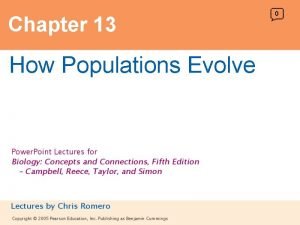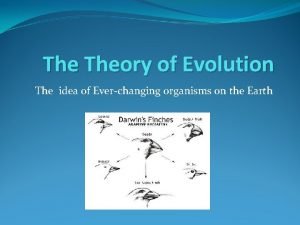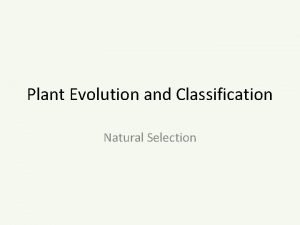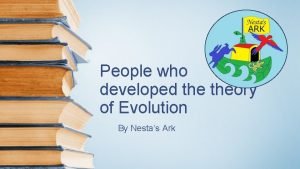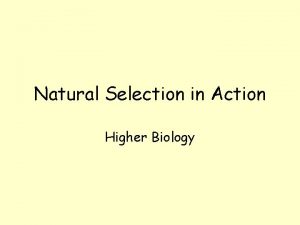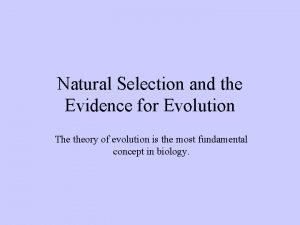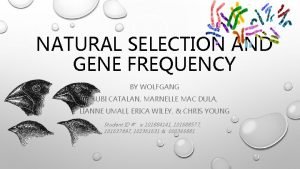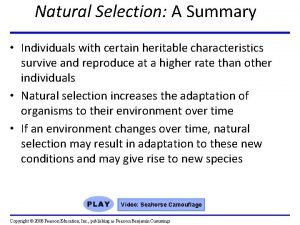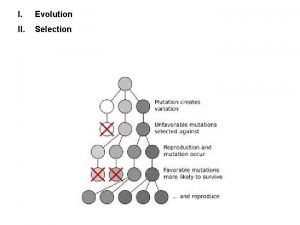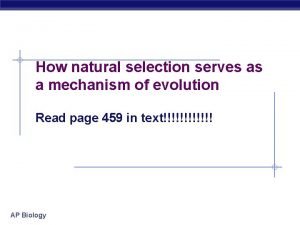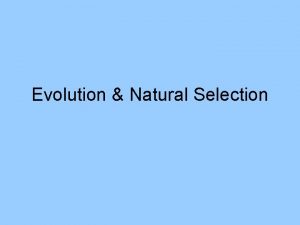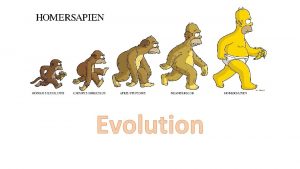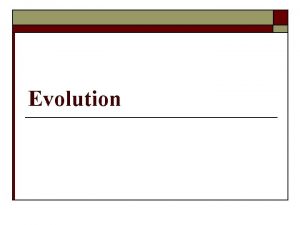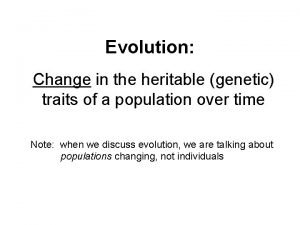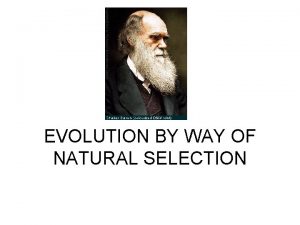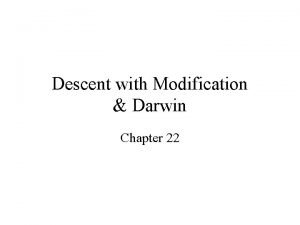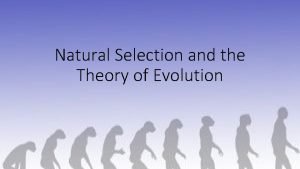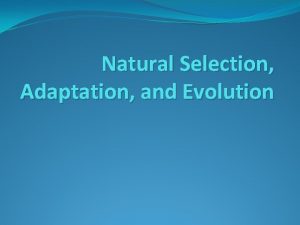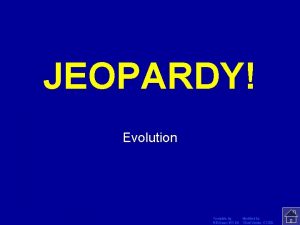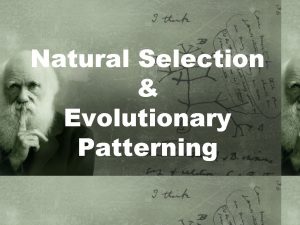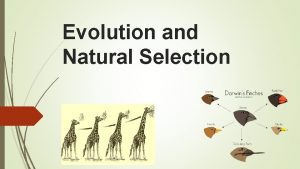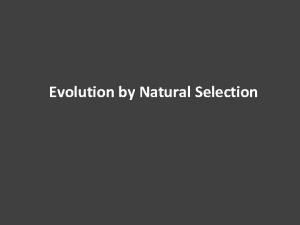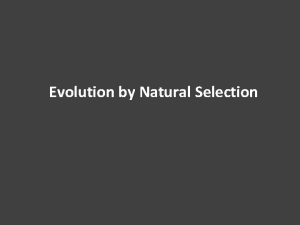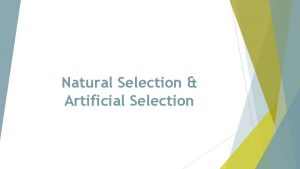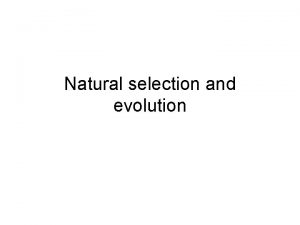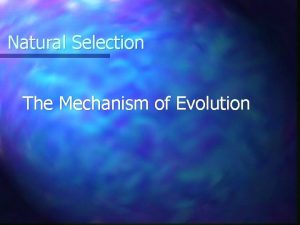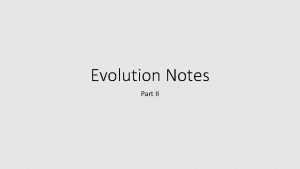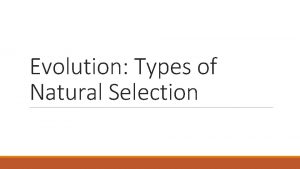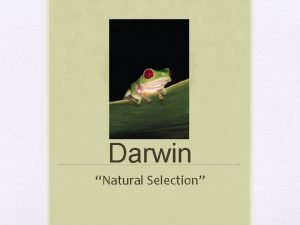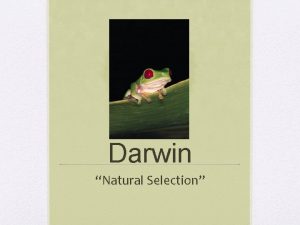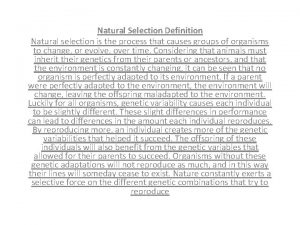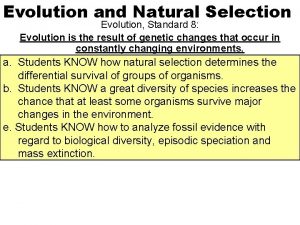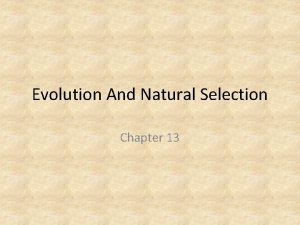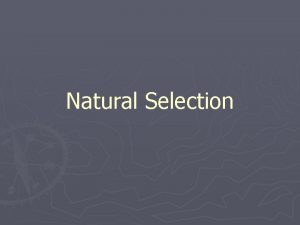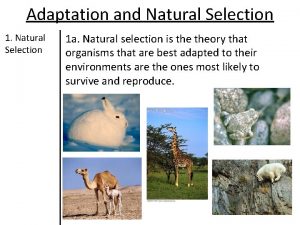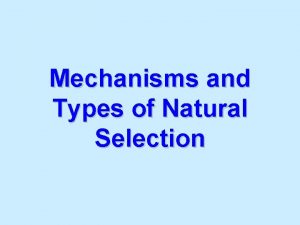Evolution and Natural Selection Evolution is the process





































































































- Slides: 101

Evolution and Natural Selection

§ Evolution is the process by which species change over time. New species develop from preexisting species over time.


§ Charles Darwin – an English naturalist who studied the diversity of life and proposed explanations for it

Charles Darwin

§ Theory – is a board explanation that has been scientifically tested and supported, theories are constantly developing and expanding

Darwin’s Ideas During Darwin’s time people didn’t think that living things had changed over time, but Darwin saw evidence of gradual change. Darwin’s evidence was collected on his global voyage on the HMS Beagle.

§ Collected fossils – began to notice that the fossils of extinct animals looked similar, but not identical, to those of animals still living today

§ Galapagos Finches – collected several different species of finches, they were all very similar however had differences in the size and shape of their beak l He noticed that each beak seemed be matched with the food it consumed


§ Noticed a lot of similarities of the island plants and animals to those found in South America (biogeography)

§ Looked at the anatomy of different species l Found homologous structures – bones or characteristics that are similar in two or more species and that have been inherited from a common ancestor of those species


Formed the idea of ‘decent with modification’ – he thought that there was one ancestral finch species that migrated from South America, then descendant finches were modified over time as different groups by eating different types of food

§ Continued his studies and came upon the idea of artificial selection… Breed pigeons based on desirable traits to pass on certain adaptations to offspring l Called artificial selections because the breeding was selected for by humans (not naturally) l

What are some examples of artificial selection that happens today?


So all this lead to the big idea that… Individuals that have traits that better suit their environment are more likely to survive and reproduce – natural selection

Darwin’s theory of evolution by natural selection says that over time, the number of individuals that carry advantageous traits will increase in a population 1. Overpopulation – every population is capable of producing more offspring than can possibly survive 2. Variation – exists within every population in the form of inherited traits

3) Selection – having a particular trait can make individuals more or less likely to survive and have successful offspring 4) Adaptation –over time those traits that improve survival and reproduction will become more common

Adaptations § A trait that makes an organism better suited to its environment § Adaptations take time and occur over many generations

Top Ten Coolest Adaptations… § Bee Orchid l Looks like a bee so other bees will be attracted to it and pollinate it

Top Ten Coolest Adaptations… § Water Spider l Makes air pockets so it can live its entire life underwater

Top Ten Coolest Adaptations… § Female Caribou l Female caribou grow antlers, the only female member of the deer family to do so. They grow their antlers late in the season, after giving birth to their calves. The females keep their antlers all winter, unlike the males which shed them in November. This give them an advantage over the males for feeding spots in the winter.

Top Ten Coolest Adaptations… § Greenland Shark l Sharks found near Greenland have a type of antifreeze in their blood which makes them toxic for humans to eat. . unless you let them rot for months. . then they are considered to be a wonderful meal.

Top Ten Coolest Adaptations… § Aye-Aye l have one very long, very special finger just so they can scoop food out of certain fruits

Top Ten Coolest Adaptations… § Chameleons l Chameleons can move their eyes in two different directions.

Top Ten Coolest Adaptations… § Emperor Penguins l Male Emperor penguins stay and hatch the egg during the long arctic winter nights, never eating the entire time. . . they loose about 25 pounds!

Top Ten Coolest Adaptations… § Woodpeckers l Woodpeckers have special cushioning in their brains, so they can hammer away with their bills, and not end up brain-dead.

Top Ten Coolest Adaptations… § Archer Fish l The Archer Fish shoots pellets of water at it's prey to knock them into the water and stun them.

Top Ten Coolest Adaptations… § Polar Bears l Polar bears have hollow hair and black skin, so they can trap more heat.

Top Ten Coolest Adaptations… § Hibernating Frogs l Several types of frogs have learned to live in deserts. The come out of the ground during the rainstorms, breed quickly, feed a bit, and just as quickly re-burry themselves into mud and spit cocoons where they can live for several years!

Darwin’s Strengths § Took a lot of time to research and organize ideas, observations and examples § Collected lots and lots of data § Gave a logical and testable mechanism for evolution – natural selection § Changed the way people view diversity, showed that variations were everywhere

Darwin’s Weaknesses § He knew very little about genetics § So he had a lot of the basic concepts but lacked the connection to genetic inheritance

§ http: //youtu. be/d. MH 0 b. Hei. RNg

Quick Review http: //youtu. be/xkw. RTIKXaxg Natural Selection – gradual change over time, based on these four concepts 1. The potential for a population to increase its numbers

2. The genetic variability of offspring due to mutation and recombination of genes l Species Variation – slight genetic differences between members of the same species • Allows for diversity within a species • Increases the chance that at least some members are adapted to the environment • Decreases the chance that one event (diseases, disasters, climate changes) will wipe out the entire species

l Mutations – a genetic change in an organism • Remember… can be helpful, harmful or have no effect • Provides genetic variation

3) A finite supply of resources required for life 4) The ensuring selection from environmental pressure leaves some of those organisms better able to survive and leave offspring

Great example of natural selection was our peppered moth lab




Evidence for Evolution § § § The Fossil Record Biogeography Embryology Anatomy Molecular and Biochemistry

The Fossil Record § Fossils are the remains of organisms or the imprint of organisms in rock. § Fossils are usually found in sedimentary rocks. § Fossils can be dated by the rocks they are found in or by Carbon Dating parts of the organism.


Fossils are important because they… § Allow us to see changes in organisms over time § Can give accurate dates of events in the past § Can give clues of how organisms lived and what type of environment there was

How can I figure out how old a fossil is? Law of superposition – rock layers on the top are younger than those on the bottom

Radiometric dating – a method of determining the absolute age of an object, often by comparing the relative percentages of a radioactive (parent) isotope and a stable (daughter) isotope http: //youtu. be/31 -P 9 pc. PStg

§ Radioactive isotopes are unstable isotopes that break down and give off energy in the form of charged particles § The time required for half of a sample of parent radioisotope to decay into a daughter isotope is called a half-life. Each isotope has a specific half life. Example - Carbon has a half life of approximately 5, 000 years, where radioactive C-14 changes to stable C-12. l

Half Life Parent Isotope Daughter Isotope 0 100 0 1 50 50 2 25 75 3 12. 5 87. 5


Relative vs. Absolute Dating

Example - Carbon has a half life of approximately 5, 000 years, where radioactive C-14 changes to stable C-12. § If a sample has 50% radioactive C-14 and 50% stable C-12 how many half lives have happened? How old is the sample? § If a sample has 25% radioactive C-14 and 75% stable C-12 how many half lives have happened? How old is the sample? § If a sample has 75% radioactive C-14 and 25% stable C-12 how many half lives have happened? How old is the sample?


Evidence for Evolution § § § The Fossil Record Biogeography Embryology Anatomy Molecular and Biochemistry

Biogeography § Different continents with similar biomes have similar organisms. § Examples Rhea, Ostrich and Emu § This suggests that similar environments shape the evolution of organisms in similar ways.

Ostrich Emu Rhea

Embryology § Scientists compare how organisms develop from embryos (fertilized eggs) until they become adults § By comparing the changes the embryos go through you can determine if organisms are related. § Example: All vertebrates have a tail and gills at some point in their development



Comparative Anatomy § The anatomy of different organisms are compared to see relationships § Homologous structures- structures that similar in two or more species § Example: Arm bones of many vertebrates have the same arrangement. § Vestigial Structures- structures that are “left over” from the past and have no clear function. Example appendix





Molecular and Biochemistry § Comparing the DNA and proteins of organisms for the number of differences § The differences are usually caused by some type of mutation § The fewer the number of differences the closer the relation between the organisms

Two theories of evolution 1) Punctuated equilibrium – quick change followed by long periods of little or no change 2) Gradualism - slow gradual change that occurs consistently § In reality most scientists believe now days that a combination of both of these theories is most likely


Reproductive Isolation – separation of a species (geographical or genetically) causing them to be unable to produce successful offspring, can cause speciation Speciation – the creation of a new species


But what is a species…. § Species – is a group of organisms capable of reproducing AND creating successful offspring

But…

No successful offspring… thus lions and tigers MUST be different species!


How Populations Evolve Forces that change allele frequencies Microevolution


Allele Frequency § Allele Frequency-The percentage of dominant alleles and recessive alleles that appear in a population § Hardy-Weinberg principle tells us the number of each allele in a population based on mathematics § The number of each allele does not change unless an evolutionary force is acting on it. it

Evolutionary Forces That Change Allele Frequency § Each of the following cause the allele frequency to change § Mutation § Gene flow (migration) § Nonrandom mating (mate choice) § Genetic drift § Natural selection

Mutation § One allele turns into another by a mutation in the genetic code § Does not occur very often and are usually lethal § Occurs 1 -10 times per 100, 000 cell divisions

Mutations § Changes that happen in one generation § May occur by a change in either the egg or sperm of a parent § May occur by a virus, drug, bacteria or radiation § May occur by an error in cell division


Gene Flow (Migration) § The movement of genes (alleles) from one population to the next § Migration l l Immigrants - bring in new alleles to a population Emigrants – take alleles out of a population

Nonrandom Mating (Mate Choice) § When we mate with individuals like ourselves we change the allele frequency to become more …… § Homozygous § A mate is usually chosen based on certain traits

Genetic Drift § Small populations and/or isolation § In small populations if a catastrophic event occurs one of the allele frequencies could be reduced § If individuals are “trapped” on an island, one of the allele frequencies could be reduced

Natural Selection § “Survival of the fittest. ” § If some alleles are “lethal” then they are selected against (reduced in number). § For example: if aa is lethal then the number of a’s in the population will go… § Down.

Great example of natural selection was our peppered moth lab




Patterns of Evolution Chapter 15 sec 3

What Cause Evolution § Isolation - organisms are isolated, which leads to interbreeding and the rise of new species

Evolution Continued § Sexual Reproduction - leads to recombination of chromosomes § Mutations - both at chromosome level and gene level.

Adaptive Radiation § Adaptive radiation - When many different species are developed from a single ancestor. Like a branching tree. § Form of divergent evolution lion House cat cheetah tiger Cat ancestor

Divergent Evolution § Divergent Evolution - is the process of two or more related species become more and more dissimilar.

More Divergent Evolution

Convergent Evolution § Convergent Evolution - unrelated species become more and more similar as they adapt to the same environment

Convergent Evolution

Coevolution § Coevolution - the joint change of two or more species in close interaction. § Often predator and prey


 The slow gradual change in a species is called
The slow gradual change in a species is called Artificial selection vs natural selection
Artificial selection vs natural selection Natural selection vs artificial selection
Natural selection vs artificial selection Artificial selection vs natural selection
Artificial selection vs natural selection Stabilizing selection human birth weight
Stabilizing selection human birth weight Natural selection vs artificial selection
Natural selection vs artificial selection Types of natural selection in evolution
Types of natural selection in evolution Mechanisms of evolution
Mechanisms of evolution Natural selection vs evolution
Natural selection vs evolution Two way selection and multiway selection
Two way selection and multiway selection Multiway selection in c
Multiway selection in c Mass selection and pure line selection
Mass selection and pure line selection Natural selection and drug resistance
Natural selection and drug resistance Natural selection and drug resistance
Natural selection and drug resistance Balancing selection vs stabilizing selection
Balancing selection vs stabilizing selection K selection r selection
K selection r selection What is exponential growth in ecology
What is exponential growth in ecology Prezygotic barriers
Prezygotic barriers Types of slection
Types of slection Natural income
Natural income Sperm parts
Sperm parts 4 principles of natural selection
4 principles of natural selection Stabilizing selection graph
Stabilizing selection graph Requirements for natural selection
Requirements for natural selection Types of natural selection
Types of natural selection Theory of natural selection
Theory of natural selection What basketball player has aids
What basketball player has aids 3 types of natural selection
3 types of natural selection Bird beak adaptation lab
Bird beak adaptation lab Genetic drift
Genetic drift Natural selection
Natural selection Four steps to natural selection
Four steps to natural selection Microevolution
Microevolution What are the principles of natural selection
What are the principles of natural selection 3 types of natural selection
3 types of natural selection Natural selection foldable
Natural selection foldable Example of vestigial structure
Example of vestigial structure Artificial selection
Artificial selection 4 principles of natural selection
4 principles of natural selection Analougous
Analougous Evolution is gradual
Evolution is gradual Three types of selection
Three types of selection Criteria for natural selection
Criteria for natural selection Natural selection simulation at phet answers
Natural selection simulation at phet answers Darwin
Darwin Basic principles of natural selection
Basic principles of natural selection Wuhsd
Wuhsd Natural selection menu
Natural selection menu Doc ff-1 pill test
Doc ff-1 pill test Natural selection images
Natural selection images Natural selection definition
Natural selection definition Basic principles of natural selection
Basic principles of natural selection Chapter 15 section 1 darwins theory of natural selection
Chapter 15 section 1 darwins theory of natural selection Natural selection
Natural selection Overproduction in natural selection
Overproduction in natural selection A habitat supplying the necessary factors for existence
A habitat supplying the necessary factors for existence 4 principles of natural selection
4 principles of natural selection Picture of natural selection
Picture of natural selection Bottleneck effct
Bottleneck effct Examples of unequal survival/reproductive success
Examples of unequal survival/reproductive success Stabilizing selection example
Stabilizing selection example Stabilizing selection example
Stabilizing selection example Natural selection examples
Natural selection examples Natural selection
Natural selection Natural selection
Natural selection Modification
Modification Natural selection
Natural selection Pseudocele
Pseudocele Criteria for natural selection
Criteria for natural selection Natural selection graphic organizer
Natural selection graphic organizer Steiner tunnel test classifications
Steiner tunnel test classifications Natural selection jeopardy
Natural selection jeopardy How do geological processes affect evolution
How do geological processes affect evolution Cheetahs can run extremely fast because
Cheetahs can run extremely fast because Natural selection picture
Natural selection picture Natural selection flow chart
Natural selection flow chart Natural selection
Natural selection Martin kreitman
Martin kreitman Genetic pool
Genetic pool Law of natural selection
Law of natural selection Plants natural selection
Plants natural selection Theory of natural selection
Theory of natural selection Action of natural selection
Action of natural selection Examples of stabilizing selection
Examples of stabilizing selection Natural selection
Natural selection Biology
Biology Natural selection
Natural selection Types of selection
Types of selection Natural selection
Natural selection Prehistoric horse
Prehistoric horse Types of natural selection
Types of natural selection Natural selection
Natural selection Giraffe evolution
Giraffe evolution Natural selection
Natural selection It is a process of change through time
It is a process of change through time Whats the theory of natural selection
Whats the theory of natural selection Natural selection conditions
Natural selection conditions Natural selection vocabulary
Natural selection vocabulary Overproduction
Overproduction Theory of natural selection
Theory of natural selection 4 premises of natural selection
4 premises of natural selection Jeopardy evolution
Jeopardy evolution
